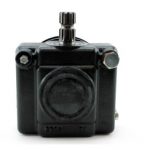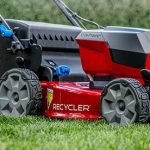Over many years a lawn can suffer a lot of abuse. Perhaps due to disease or extreme summer heat a section of your lawn loses grass, foot traffic wears down a path, or grass doesn’t sprout in

There are two ways to repair a lawn, over seeding or patching.
(Courtesy: Jeff and Chika Griswold at flickr.com)
shadowed locations. Under these circumstances and others you might find the need to repair your lawn.
There are two methods to repairing a lawn –- over seeding or patching.
Over Seeding
The process of over seeding to repair a lawn is ideal if more than 50 percent of the good grass remains and the improvement you’re after includes increased thickness and a greener color.
First, you need to determine why the lawn has deteriorated. Issues that can cause the need for lawn repair include a high amount of foot traffic, shade, drought, or disease. Determining why the damage occurred in the first place can help you select the proper specie of grass seed that can overcome the problem. For example, if shade is the issue, then select specie of grass seed that thrives in the shadows. If the issue is drought, then select grass seed specie that retains water, etc.
It is essential that the seed have good contact with the soil. You can follow the following procedure:
1. Mow the existing lawn very, very short, almost to the point of scalping it.
2. If your mower doesn’t include a bag that can catch the clippings, then rake them up. This assures that the soil is exposed.
3. Scratch the soil as hard as you can with a metal garden rake. This roughs the ground up and creates a good seedbed.
4. Apply seed at two to three times the recommended amount suggested on the seed bag.
5. Cover the seed with a ¼-inch of topsoil or finely ground compost.
6. Water every day to keep the seeds wet until they sprout.
7. Allow the sprouts to grow about 3-inches to 4-inches, then mow.
8. Cut the grass about one-third of its height.
Patching
The method of patching is ideal if your lawn looks great overall and there are only a few trouble spots.
As with the method of over seeding, determine what caused the damage. A bare patch or spot is usually due to poor drainage, soil compaction, chemical spill or too much shade.
If the bare spot is the result of a spill, flush the soil and remove the chemicals. If the trouble is due to compaction, then aerate the area, mix compost into the soil, and apply some gypsum to assist with drainage. If shade is the culprit, select grass specie that thrives in it.
Next, prepare a good seedbed. You achieve that by:
· Removing any grass or weeds from the bad area.
· Enlarging the area by about 6-inches beyond the spot.
· Digging or rototilling down to 5-inches to 6-inches.
· Removing any rocks, weeds, roots, or debris.
· Adding 2-inches to 3-inches of topsoil or compost and mixing with the soil.
· Leveling off the area and then pouring water into it.
Now that the seedbed has been created, you can use one of three methods to patch the area, you can seed it, sod it, or plug it.
To seed it:
· Spread the seed as recommended on the seed package.
· Cover with about one-quarter of an inch of topsoil.
· Moisten until the seeds sprout.
· Let the seedlings grow to 3-inches to 4-inches and then mow.
· Mow the grass down to only one-third its height.
To sod it:
· Cut a piece of sod to match the size of the patch.
· Lay the sod and roll it or press it down firmly to assure good contact with the soil.
· Water the sod and the soil under it regularly for at least two weeks.
· Let it sprout about 3-inches to 4-inches, then mow.
To plug it:
· Gather small plugs from the healthy portion of your lawn.
· Plant the plugs 4-inches to 6-inches apart depending on how fast you want it to fill in.
· Water the soil evenly for about a month so the roots will establish.
· Keep the area free of weeds to allow the new grass to fill in.






